Bells and Bits

Beez Neez now Chy Whella
Big Bear and Pepe Millard
Mon 28 Apr 2014 22:47
|
Bells and Bits
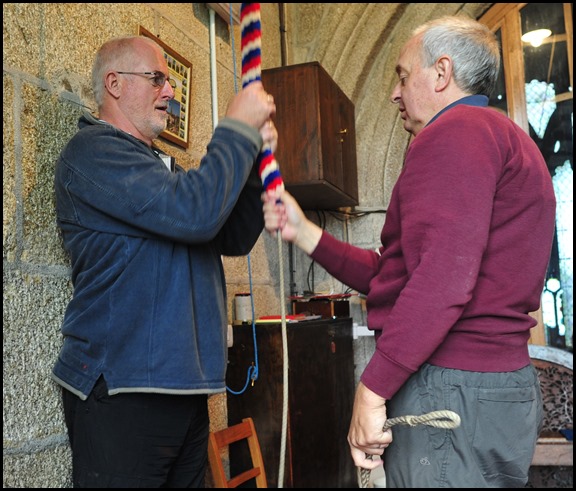 Having been present at Bears first ever lesson at bell ringing, under the expert tutelage
of Geoff, and, had a go myself, I wanted to know more about the wide
subject of church bells, bell ringing and bells in general. This is a massive
subject so I picked the bits I found really interesting and here they
are.
 In AD 400, Paulinus of Nola introduced church bells into the Christian
Church. In AD 604, Pope Sebinianus officially sanctioned their usage. By the
early Middle Ages, church bells became even more common in Europe. They were
first common in Europe, reflecting Celtic influence, especially that of Irish
missionaries. Before the use of bells, Greek monasteries would ring a flat metal
plate to announce services. The signa and campanae used to
announce services before Irish influence may have been flat plates like
semantron rather than bells.
The oldest surviving circle of bells
in Great Britain is housed in St Lawrence Church, Ipswich. The bells were cast
in the 1440’s and stopped being used in 1985 when it was declared the tower they
were housed in was no longer stable. In 2009, they were moved further down the
tower on to a new cast iron frame where they were once again brought into use.
The re-housing and restoration of the bells was part of a one hundred thousand
pound grant by the Ipswich Historic Churches Trust.
The oldest church bell in the world
is one donated by the Despot Alexius Slav to the metropolitan church in Melnik,
Bulgaria, and dated 1211-1216. It is now kept at the National Museum of History
in Sofia.
In World War II in Great Britain, all
church bells were silenced, to ring only to inform of an invasion by enemy
troops.
Reginald Bray was born on the 28th of
October 1902 and was an active member of the bell ringing team of St Cyr and St
Julitta, Newton St Cryes, Devon. On the 30th of October 2003 he rang a ‘touch’
of grandsire doubles – two days after his one hundred and second
birthday.
 St Dunstan
is the Patron Saint of Bell Ringers. He was born in the year AD 909 and died on
the 19th of May 988. He was Abbott of Glastonbury, Bishop of Worcester and the
Archbishop of Canterbury. He was a much loved priest attending to the spiritual
needs of his people, promoting peace throughout the land, and restoring
churches. By being concerned with the architectural fabric of the Church allowed
his creative side to experiment with and develop the design and forging of
bells. It was his success in this and the subsequent importance given to the
role that the sound of bells had amongst communities across the land that
endeared him to bell ringers which lasts to this day. He is buried in Canterbury
Cathedral and is acknowledged on the right hand side of the High Altar. He was
later canonised and his feast day is May the 19th.
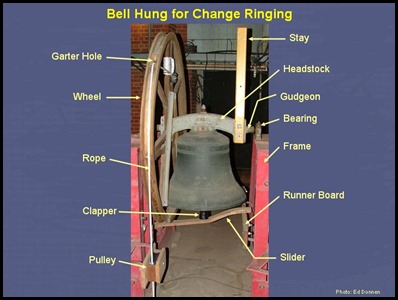 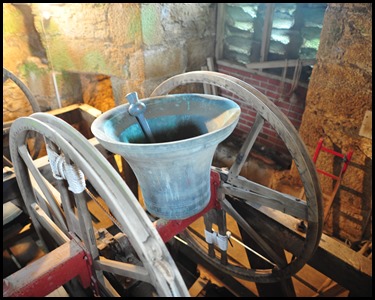 Change Ringing:
Ringing in English belltowers became a popular hobby in the late 17th century,
in the Restoration era; the scientific approach which led to modern method
ringing can be traced to two books, Tintinnalogia or the art of ringing
– published in 1668 by Richard Duckworth and Fabian Stedman and
Campanalogia. Today change ringing remains
most popular in England but is practiced worldwide; over four thousand peals
rung each year.
In English style full circle ringing
the bells in a church tower are hung so that on each stroke the bell
swings through a complete circle – actually a little more than three hundred and
sixty degrees. Between strokes, it sits poised ‘upside-down’, with the mouth pointed upwards; pulling on a
rope connected to the bell swings it down and its own momentum swings it back up
again on the other side. These rings of bells have relatively few bells,
compared with a carillon; six or eight-bell towers are common, with the largest
rings in numbering up to sixteen bells. The bells are usually tuned to fall in a
diatonic scale without chromatic notes; they are traditionally numbered from the
top downwards so that the highest bell – the treble – is numbered one and the
lowest bell – the tenor – has the highest number; it is usually the tonic note
of a bells’ scale.
To swing heavy bells requires a
ringer for each bell. Furthermore, the great inertias involved mean that the
ringers have only a limited ability to retard or accelerate their bells’ cycle.
Along with the relatively limited palette of notes available, the upshot is that
such rings of bells do not easily lend themselves to ringing melodies. Instead,
a system of change ringing evolved, probably early in the seventeenth century,
which centres on mathematical permutations.
The ringers begin with rounds, which is simply ringing down the scale
in order. On six bells this would be 123456. The ringing then proceeds in a
series of rows or changes, each of which is some permutation
of rounds, for example, 214365, where no bell changes by more than one position
from the preceding row. This is also known as the Steinhaus-Johnson-Trotter
Algorithm.
In call change ringing, one of the
ringers – known as the conductor or in our case Geoff, calls out to tell the
other ringers how to vary the order from row to row. Some ringers practice call
changes exclusively; but for others, the essence of change ringing is method
ringing.
 Method Ringing: In
method or scientific ringing each ringer has memorised a pattern describing his or her bell’s
course from row to row; taken together, these patterns – along with only
occasional calls made by the conductor, form an algorithm which cycles
through the various available permutations.
Serious ringing always starts and
ends with rounds; and it must be true – each row must be unique, never
repeated. A performance of all the possible permutations on a set of bells is
called an extent. An extent on seven bells is a peal or 5,040
rings; eight bells would mean 40,320 rings. On ten bells it doesn’t bear
thinking about, but, lots and lots with no doubt many complaints from the
neighbours and the bats.
   The Ancient Society of
College Youths – ASCY: is the world’s premier society
of church bellringers, founded in 1637 and based in the City of
London.
History: The Society is said to be
founded on the 5th of November 1637, although it is possible that it was
actually in existence before this date. The first Master is noted as Lord
William Brereton. The first ringing by the Society was recorded in c.1642 when
it managed “a plain six-score on five bells”. Robert Roan, Master in 1652, is
said to have invented Grandsire Doubles and Plain Bob Minor.
Achievements: Since its formation the ASCY has
been a leader in ringing achievement, including large numbers of “long length”
peals – ringing for up to seventeen hours continuously. The first of these long
lengths took place on the 18th of May 1728, and consisted of 10,080 changes of
Plain Bob Major. More recently, three members of the ASCY – Philip Earis, Andrew
Tibbetts and David Pipe – have rung the longest peal ever, on handbells,
consisting of 72,000 changes of Minor, ringing one hundred different methods,
all of which had to be memorised and taking twenty four hours and nine
minutes.
The Society also rang the ‘extent’ or
maximum number of permutations in the Order of the Bells of Major – 40,320
changes, on the 27th of December 1977, taking fifteen hours and fifty nine
minutes to do so. The ASCY is responsible for the bells at St
Giles-without-Cripplegate, St Lawrence Jewry, St Sepulchre-without-Newgate, St
Magnus the Martyr and St Michael, Cornhill. Its members hold regular practices
at these towers, as well as at St Pauls Cathedral, St Mary-le-Bow and Southwark
Cathedral.
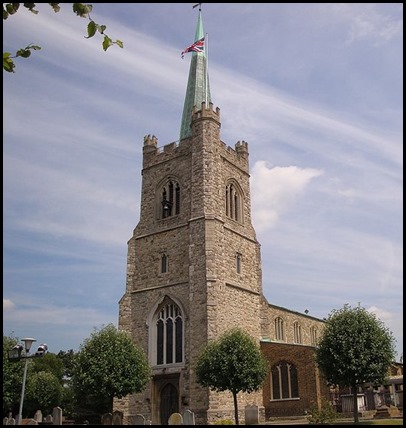 St Andrew’s,
Hornchurch. During the Anglian ice age around 450,000 years ago, the ice
sheet reached The Dell, a few yards south of the current location of the church.
This is the farthest south reached by any ice sheet in Britain during the
Pleistocene epoch. There has been a church on this site since at least 1163. The
tower and north porch were added in the 15th century. The tower contains ten
bells hung in a clockwise ring. The tenor is 18cwt or 2,016 pounds in Eb or
622.0 Hz dating from 1779. The bells were augmented from six bells to eight in
1901, then from eight to ten in 2001. On Monday the 27th of May 1912 a band of
ringers led by William Pye rang apeal of 15,264 changes of Bristol Surprise
major in nine hours and forty nine minutes. This was at the time the longest
length rung in any surprise method.
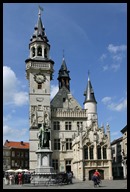 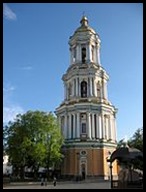

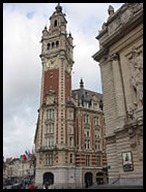 Aalst in
Belgium. Lavra in Kiev. Zoravar in Armenia. Lille in
France.
Numbers: As of the
31st of December 2013 there are 7,135 English style rings in working order world
wide. The Netherlands, Parkistan, India and Spain have one each. The Windward
Islands and the Isla of Man have two each. Canada and New Zealand have eight
each. The Channel Isles have ten. Africa as a continent has thirteen. Scotland
has twenty three. Ireland has thirty seven. The USA has forty six. Australia has
fifty seven and Wales has two hundred and twenty seven. The remaining 6,698 are
in England – including three mobile rings.
The Three Biggest Bells in the
World by Weight.
 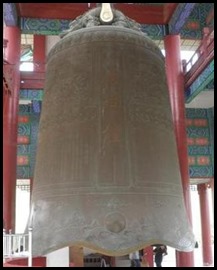
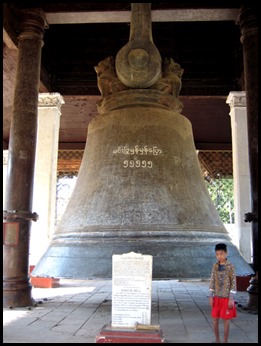 The Tsar
Bell, Kremlin, Moscow. Weighs in at 433,356 pounds. Cast in 1735 by Ivan
Feodorovich Motorin, it was commissioned by Empress Anna Ivanovna, niece of
Peter the Great. The Tsar Bell is twenty and a bit feet tall and twenty two feet
in diameter. The bell is on display in the grounds of the Kremlin.
The Bell of Good
Luck, Foquan Temple, Henan, China. Weighs 255,200 pounds. Cast by the
Tianrui Group. It is close to one of the world’s tallest Buddha statues. The
bell is twenty six feet seven inches tall and sixteen feet seven inches in
diameter at its widest point. The bell of Good Luck therefore, at the time of
construction, claimed the title of the heaviest functioning bell in the world.
The bell was cast in December 2000 and first rung at midnight on New Year’s Eve
that same month. The bell’s shoulder section is adorned with thirty six lotus
petal patterns.
The Mingun
Bell, Mingun, Myanmar. Weighs 199,999 pounds. Cast in 1808 by an unknown
maker. The height of the bell is twelve feet on the exterior and eleven and a
half feet in the interior. The outer diameter of the rim of the bell is sixteen
feet, three inches. The outside circumference at the rim is nearly fifty one
feet. The thickness of the bell is six to twelve inches and the whole thing
stands over twnty feet from rim to the top. The bell is uncracked and in good
ringing condition. The bell does not have a clanger but is rung by striking the
outer edge.
Three Famous
Bells
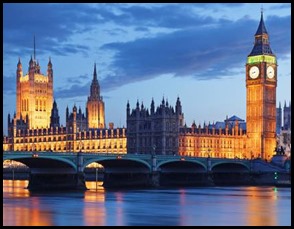  Big Ben. The main
bell, officially know as the Great Bell, is the largest bell in the
tower and part of the Great Clock of Westminster. The bell is better known by the nickname Big Ben. The original bell was a sixteen ton hour bell,
cast on the 6th of August 1856 in Stockton-on-Tees by John Warner & Sons.
The bell was transported to the tower on a trolley drawn by sixteen horses, with
crowds cheering its progress. Unfortunately, it cracked beyond repair while
being tested and a replacement had to be made. The bell was recast on the 10th
of April 1858 at the Whitechapel Bell Foundry as a thirteen and a half ton bell.
This was pulled up to the Clock Tower’s belfry, a feat that took eighteen hours.
It is seven feet six inches tall and nine feet in diameter. The new bell first
chimed in July 1859. In September it too cracked under the hammer, a mere two
months after it officially went into service. According to the foundry’s
manager, George Mears, Denison had used a hammer more than twice the maximum
weight specified. For three years Big Ben was taken out of commission and the
hours were struck on the lowest of the quarter bells until it was reinstalled.
To make the repair, a square piece of metal was chipped out of the rim around
the crack, and the bell given an eighth turn so chimed with a slightly different
tone ever since and is still in use today – complete with crack. At the time of
its casting, Big Ben was the largest bell in the British Isles until “Great
Paul” in St Paul’s Cathedral was cast in 1881.
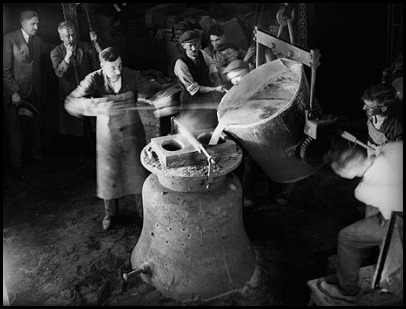 Molten metal poured into a cast for a
church at the Whitechapel Foundry, 1933.
Whitechapel
Foundry: The monasteries originally established foundries for themselves with
St. Dunstan a leading light on the craft but the first commercial works were
founded in East London in 1570. This was the Whitechapel Foundry which is
considered the oldest manufacturing company in Britain. Its work has continued
unbroken in the creation of bells of all sizes with a short break during the war
when they had to divert their skills to producing armaments. The largest bell
ever cast was Big Ben. The world’s first peal of sixteen change ringing bells
was installed in St. Martin’s, Bull Ring, in Birmingham.
The original foundry was consumed by
the Great Fire and so the present buildings date from 1670 and are now Grade II
listed. The longevity of the foundry is such that they have celebrated four
hundred years of existence during which time twenty seven monarchs have reigned.
The Whitechapel Foundry now has worldwide fame creating bells for cathedral and
churches all over the world. It has played a hugely important role in the
evolvement of casting, the technology of hanging the bells and in the manner in
which they are rung.
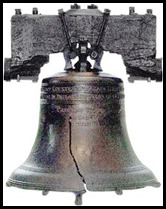 Notable Bells: In
1752 the foundry cast the Liberty Bell which was
commissioned to celebrate the 50th anniversary of William Penn’s 1701 Charter of
Privileges, Pennsylvania’s original constitution. The bell cracked in 1846 when
it was first rung to mark the birthday of George Washington. From 2003, the bell
has been housed at the Liberty Bell Centre near Independence Hall. The foundry
produced “Great Tom” at Christ Church, Oxford, which can be heard from a
distance of thirteen miles. Many churches across the world have had bells cast
by this foundry and the one I found you could buy new bell ropes from – own
blog.
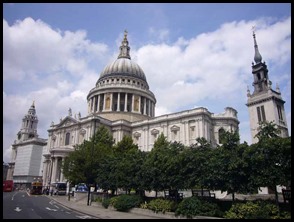 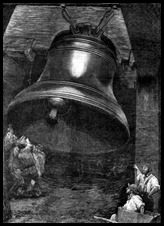 Great Paul and the
Clock Bells of St Paul’s Cathedral: The South West
Tower houses Great Paul, the largest bell in the
British Isles, which weighs sixteen and a half tons. Sadly, Great Paul has not
sounded for several years because of a broken chiming mechanism. Also in the
South West tower are the three clock bells. The largest of these, Great Tom, was
cast by Richard Phelps in 1706 and weighs over five tons. As well as striking
the hours, by tradition Great Tom is tolled on the death of senior members of
the Royal Family, the Archbishop of Canterbury, the Bishop of London, the Dean
of St Paul’s or the Lord Mayor of London. It was last tolled following the death
of H.M. Queen Elizabeth, the Queen Mother, in 2002.
Change Ringing:
Except for full peals, which at St Paul’s involve approximately four hours of
continuous ringing, each bell is always rung by one ringer. For full peals there
are sometimes two ringers on the tenor. Change
ringing requires both physical and mental ability and it takes most ringers
several years to become sufficiently skilled to ring on the challenging bells of
St Paul’s. Although the musical qualities of the sound produced is a
consideration, change ringing “music” at St Paul’s is based as above on
numerical principles. Full peals are normally rung on New Year’s Day and Easter
Monday each year as well as on special occasions. In the early days, when full
peals were rare, they were all recorded on the walls of the ringing chamber.
These days, only very special peals are written on the wall but a peal book is
maintained.
Service Bell: In
addition to the twelve bells in the North West tower, there is the original
service bell affectionately known as The Banger. This was cast by Philip
Wightman in 1700 when the building of the West towers was completed. It remained
alone for 178 years until the ring of twelve bells was cast in 1878. The Banger
is still regularly rung to this day prior to the 8am Eucharist.
John Taylor &
Co: The first connections to bells was by a Johannes de Stafford who
was a bell founder in the 14th century. The Taylor family bought the business in
1784 and it has been based at its present site in Loughborough since 1839.
Notable Bells: Other
than “Great Paul”, the foundry has cast “Great George” for Liverpool Cathedral
which is the second largest bell in Britain,and “Little John” for Nottingham
cast in 1928. The foundry is now the largest bell foundry in the
world.
  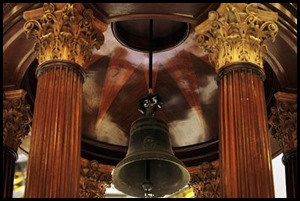 Lutine was a frigate
which served in both the French Navy and the Royal Navy. She was launched by the
French in 1779. The ship passed to British control in 1793 and was taken into
service as HMS Lutine. She sank among the West Frisian
Islands during a storm in 1799.
The Lutine Bell: The
ship’s bell, engraved “ST. JEAN – 1779”, was recovered on the 17th of July 1858.
The bell was found entangled in the chains originally running from the ship’s
wheel to the rudder, and was originally left in this state before being
separated and rehung from the rostrum of the Underwriting Room at Lloyd’s. It weighs one hundred and six pounds and eighteen
inches in diameter. It remains a mystery why the name on the Lutine Bell does not correspond with that of the ship. The
bell was traditionally struck when news of an overdue ship arrived – once for
the loss of a ship – bad news, and twice for her return – good news. The bell
was sounded to ensure that all brokers and underwriters were made aware of the
news simultaneously. The bell developed a crack and the traditional practice of
ringing news has ended; the last time it was rung to tell of a lost ship was in
1979 and the last time it was rung to herald the return of an overdue ship was
in 1989.
During World War II, the Nazi radio
propagandist Lord Haw-Haw asserted that the bell was being rung continuously
because of allied shipping losses during the Battle of the Atlantic. In fact,
the bell was rung once, with one ring, during the war, when the Bismark was
sunk. It tolls when a member of the Royal Family dies and was heard after
the deaths of Diana, Princess of Wales and Queen Elizabeth the Queen Mother. It
is now rung for ceremonial purposes to commemorate disaster such as the 9/11
disaster, the Asian Tsunami, the London Bombings, and is always rung at the
start and end of the two minute silence on Armistice Day.
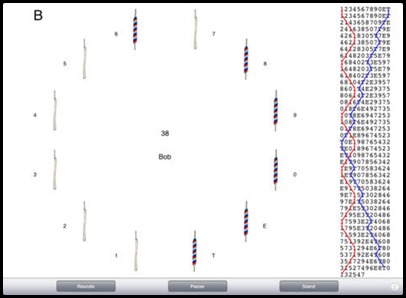 During my interesting
bimble around the World Wide Web, I have found such things as an all inclusive
weekend to learn the art of bell ringing. Perhaps the most interesting thing of
all was something Geoff showed me. An App. You can
set how many bells there are in your virtual bell tower, which bell you want to
be in charge of, which pattern or ‘tune’ you want to be part of and at the end
it will tell you how many mistakes you have made. Geoff patiently showed me how
it worked and when I needed more details went to the piano and ran through it
for me. Incredibly there is information on every church, how many bells and what
their pitches are, which night and time the bell ringers have their practice
night and so much more. I was fascinated to hear that there are groups of
ringers who use this information to put trips and outings together, to visit
one, two, three or four churches, make a weekend of it or go all out to see how
many they can fit in. WOW.
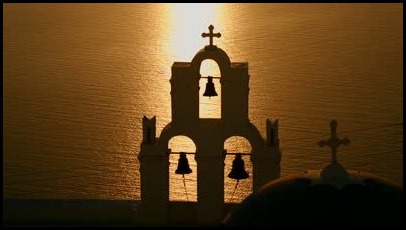 ALL IN ALL REALLY
ENJOYED RESEARCHING THIS BLOG
REALLY
INTERESTING
|